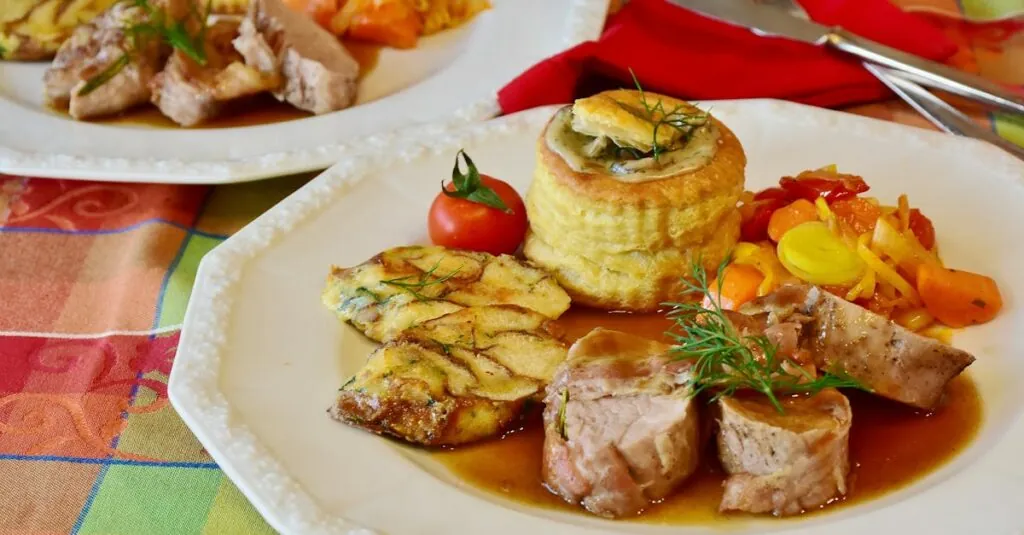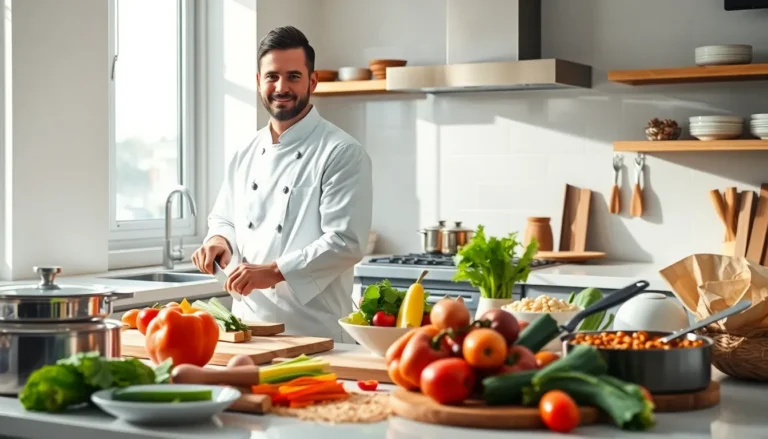Table of Contents
ToggleIn a world where microwave dinners reign supreme, fancy cooking techniques can feel like a culinary fairy tale. But what if whipping up a gourmet meal didn’t require a magic wand? With a sprinkle of creativity and a dash of practice, anyone can elevate their home cooking from basic to breathtaking.
Overview of Fancy Cooking Techniques
Fancy cooking techniques elevate home meals and make culinary skill accessible. Sous vide cooking immerses food in a temperature-controlled water bath for precise results. This method ensures consistent cooking and retains moisture, flavor, and nutrients.
Another technique, molecular gastronomy, involves using scientific principles to transform flavors and textures. Chefs employ ingredients like liquid nitrogen to create surprising presentations, such as frozen foams or delicate spheres. This approach engages the senses and adds excitement to dining experiences.
Presentation techniques significantly impact the perception of dishes. Plating artfully enhances visual appeal by arranging food thoughtfully on the plate. Using garnishes, sauces, and varied textures provides an extra layer of sophistication that impresses diners.
Charcuterie gives an opportunity to explore curing and preservation methods. By preparing meats and cheeses with various seasonings and techniques, individuals create a charcuterie board that highlights flavors and showcases culinary creativity.
Smoking foods introduces complex flavors and offers a unique aspect to cooking. Methods like hot and cold smoking can infuse meats, vegetables, and even cheeses with rich, smoky tones that enhance overall taste.
Fermentation is another trendy technique. Fermented foods, such as kimchi or sourdough, develop unique flavors and beneficial probiotics. Embracing this technique broadens culinary horizons and encourages experimentation.
Emphasizing these fancy techniques allows home cooks to explore the culinary world. With practice, even simple meals can be transformed into extraordinary creations.
Sous Vide Cooking
Sous vide cooking enhances the cooking process by providing precise temperature control through low and slow immersion in a water bath. This technique transforms food into tender, flavorful creations.
Equipment Needed
To start sous vide cooking, several essential items are required. A sous vide immersion circulator maintains water temperature accurately. A heat-safe container holds the water bath, while vacuum-sealed bags ensure even cooking. A sealing device, whether a vacuum sealer or zipper bags, is necessary for food preparation. Tongs facilitate safe food handling post-cooking. Using these tools creates optimal conditions for immersing ingredients, allowing for consistent results.
Step-by-Step Process
Begin the sous vide process by selecting the desired ingredients, like meats or vegetables. Season the food to enhance flavors, then place it inside a vacuum-sealed bag. Next, set the immersion circulator to the target temperature, based on the type of food being prepared. Once the water reaches the desired temperature, submerge the bag and cook for the recommended time. After cooking, remove the bag from the water bath, open it carefully, and pat the food dry. Finally, sear or finish the exterior for presentation and additional flavor if desired.
Molecular Gastronomy
Molecular gastronomy combines science and culinary arts to create innovative dining experiences. It employs scientific techniques to transform flavor and texture, surprising diners with unexpected presentations.
Key Ingredients
Utilizing unique ingredients is essential for molecular gastronomy. Sodium alginate allows for spherification, creating caviar-like beads from liquids. Calcium chloride acts as a firming agent, essential for gelatinous textures. Other popular components include agar-agar, a plant-based alternative to gelatin, and lecithin, used for emulsifying. These ingredients enable chefs to push culinary boundaries and explore new flavor profiles.
Techniques to Explore
Experimenting with molecular gastronomy techniques is exciting and rewarding. Spherification allows liquids to form gelatinous spheres, bursting with flavor. Foam creation introduces air into liquids, enhancing presentation and texture. Sous vide techniques, combined with molecular gastronomy, ensure precise temperature control, producing tender and flavorful results. Additionally, gelification transforms liquids into gels, offering unique mouthfeel experiences. Mastering these methods opens pathways to innovate dishes that captivate both sight and palate.
Gourmet Plating Styles
Gourmet plating styles enhance the visual appeal of dishes, making meals more inviting. Attention to detail in presentation transforms ordinary food into exceptional culinary experiences.
Color and Texture Balance
Achieving color and texture balance plays a crucial role in plating. Bright ingredients like roasted bell peppers or vibrant herbs add visual interest to dishes. Contrasting textures, such as crispy toppings on creamy sauces, create an engaging sensory experience. Using a variety of shapes, sizes, and colors enhances the overall allure and encourages diners to explore the dish. Incorporating elements like edible flowers or microgreens can elevate the aesthetic impact, leaving a lasting impression.
Creative Garnishing Ideas
Innovative garnishing ideas contribute significantly to gourmet plating. Fresh herbs like basil or cilantro can add a pop of color and aroma, enhancing the dish’s attractiveness. Thinly sliced vegetables arranged artistically add both texture and visual complexity. For a unique flair, consider using flavored oils, sauces, or colorful coulis in creative patterns around the plate. Edible flowers or flavored froths serve as eye-catching garnishes that intrigue diners. Each chosen garnish should complement the dish’s flavors while enhancing its overall presentation.
Advanced Baking Techniques
Mastering advanced baking techniques can elevate one’s culinary skills. The following methods highlight creativity and precision in baking.
Pastry Arts
Pastry arts encompass a variety of techniques including laminating dough, creating intricate desserts, and crafting delicate pastries. Laminating dough involves folding butter into flour multiple times to create flaky layers, essential for croissants and danishes. Crafting éclairs requires careful piping and baking to achieve the ideal texture for holding fillings. Tools like a pastry cutter, bench scraper, and pastry bags significantly enhance the pastry-making process. Patience is crucial as precise measurements and temperatures play a vital role. Each technique enhances the flavors and textures, transforming baking from basic to extraordinary.
Specialty Breads
Specialty breads offer a chance to experiment with unique ingredients and methods. Sourdough stands out for its natural fermentation process, which enhances flavor and texture. Using a starter culture introduces beneficial bacteria and yeast, creating a distinctive taste. Focaccia, topped with herbs and olive oil, combines ease with flavor for an impressive bread option. Other artisan breads like ciabatta and baguettes require specific hydration levels and shaping techniques for optimal results. Incorporating seeds or grains adds nutritional value and complexity. Every specialty bread brings its character, showcasing the art of baking in delicious ways.
Embracing fancy cooking techniques can transform the way home cooks approach their meals. By integrating methods like sous vide and molecular gastronomy, anyone can elevate their culinary creations and impress family and friends.
The art of plating and garnishing adds an essential visual component that enhances the dining experience. With a bit of creativity and practice, even the simplest dishes can become extraordinary.
Exploring advanced baking techniques and specialty breads opens new avenues for flavor and texture. Home cooks are encouraged to experiment with these techniques, bringing excitement and innovation into their kitchens. The journey of culinary exploration is limitless, inviting everyone to enjoy the process of creating memorable meals.



